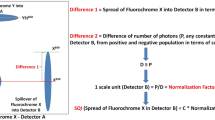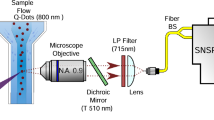Abstract
This protocol outlines a three-part quality assurance program to optimize, calibrate and monitor flow cytometers used to measure cells labeled with five or more fluorochromes (a practice known as polychromatic flow cytometry). The initial steps of this program (system optimization) ensure that the instrument's lasers, mirrors and filters are optimally configured for the generation and transmission of multiple fluorescent signals. To determine the sensitivity and dynamic range of each fluorescence detector, the system is then calibrated by measuring fluorescence over a range of photomultiplier tube (PMT) voltages by determining the PMT voltage range and linearity (Steps 2–10) and validating the PMT voltage (Steps 11–17). Finally, to ensure consistent performance, we provide procedures to monitor the precision, accuracy and sensitivity of fluorescence measurements over time. All three aspects of this program should be performed upon installation, or whenever changes occur along the flow cytometer's optical path. However, only a few of these procedures need to be carried out on a routine basis.
This is a preview of subscription content, access via your institution
Access options
Subscribe to this journal
Receive 12 print issues and online access
$259.00 per year
only $21.58 per issue
Buy this article
- Purchase on Springer Link
- Instant access to full article PDF
Prices may be subject to local taxes which are calculated during checkout






Similar content being viewed by others
References
De Rosa, S.C., Brenchley, J.M. & Roederer, M. Beyond six colors: a new era in flow cytometry. Nat. Med. 9, 112–117 (2003).
De Rosa, S.C., Herzenberg, L.A. & Roederer, M. 11-color, 13-parameter flow cytometry: identification of human naive T cells by phenotype, function, and T-cell receptor diversity. Nat. Med. 7, 245–248 (2001).
Delobel, P. et al. Persistence of distinct HIV-1 populations in blood monocytes and naive and memory CD4 T cells during prolonged suppressive HAART. AIDS 19, 1739–1750 (2005).
Brenchley, J.M. et al. T-cell subsets that harbor human immunodeficiency virus (HIV) in vivo: implications for HIV pathogenesis. J. Virol. 78, 1160–1168 (2004).
Perfetto, S.P., Chattopadhyay, P.K. & Roederer, M. Seventeen-colour flow cytometry: unravelling the immune system. Nat. Rev. Immunol. 4, 648–655 (2004).
Chattopadhyay, P.K. & Roederer, M. Immunophenotyping of T cell subpopulations in HIV disease. in Current Protocols in Immunology (eds. Coligan, J.E., Bierer, B., Margulies, D.H., Shevach, E.M. & Strober, W.) 12.12.1–12.12.15 (John Wiley & Sons, Hoboken, New Jersey, USA, 2005).
Roederer, M. Multiparameter FACS analysis. in Current Protocols in Immunology (eds. Coligan, J.E., Bierer, B., Margulies, D.H., Shevach, E.M. & Strober, W.) 5.8.1–5.8.10 (John Wiley & Sons, New York, 2002).
Pattanapanyasat, K. & Thakar, M.R. CD4+ T cell count as a tool to monitor HIV progression & anti-retroviral therapy. Indian J. Med. Res. 121, 539–549 (2005).
De Rosa, S.C. et al. Vaccination in humans generates broad T cell cytokine responses. J. Immunol. 173, 5372–5380 (2004).
Brown, A.E. et al. Clinical prognosis of patients with early-stage human immunodeficiency virus (HIV) disease: contribution of HIV-1 RNA and T lymphocyte subset quantitation. Mil. Med. 166, 571–576 (2001).
Rosner, E. et al. Assessment of the impact of a CD4+ T-cell testing laboratory improvement program. Arch. Pathol. Lab. Med. 122, 512–519 (1998).
Bergeron, M. et al. Impact of unified procedures as implemented in the Canadian Quality Assurance Program for T lymphocyte subset enumeration. Participating Flow Cytometry Laboratories of the Canadian Clinical Trials Network for HIV/AIDS Therapies. Cytometry 33, 146–155 (1998).
Schenker, E.L. et al. Evaluation of a dual-color flow cytometry immunophenotyping panel in a multicenter quality assurance program. Cytometry 14, 307–317 (1993).
Liu, C.M., Muirhead, K.A., George, S.P. & Landay, A.L. Flow cytometric monitoring of human immunodeficiency virus-infected patients. Simultaneous enumeration of five lymphocyte subsets. Am. J. Clin. Pathol. 92, 721–728 (1989).
Horan, P.K., Muirhead, K.A. & Slezak, S.E. Standards and controls in flow cytometry. In Flow Cytometry and Sorting 2nd edn. (eds. Melamed, M. et al.) 397–414 (Wiley-Liss, New York, 1990).
Shapiro, H.M. Practical Flow Cytometry (Wiley-Liss, Hoboken, New Jersey, USA, 2003).
Schwartz, A., Marti, G.E., Poon, R., Gratama, J.W. & Fernandez-Repollet, E. Standardizing flow cytometry: a classification system of fluorescence standards used for flow cytometry. Cytometry 33, 106–114 (1998).
Schwartz, A., Fernandez Repollet, E., Vogt, R. & Gratama, J.W. Standardizing flow cytometry: construction of a standardized fluorescence calibration plot using matching spectral calibrators. Cytometry 26, 22–31 (1996).
Schwartz, A. et al. Formalization of the MESF unit of fluorescence intensity. Cytometry B Clin. Cytom. 57, 1–6 (2004).
Zenger, V.E., Vogt, R., Mandy, F., Schwartz, A. & Marti, G.E. Quantitative flow cytometry: inter-laboratory variation. Cytometry 33, 138–145 (1998).
Marti, G.E. et al. (eds.) Fluorescence calibration and quantitation measurement of fluorescence intensity: approved guideline. (Clinical Laboratory Standards Institute, National Committee for Clinical Laboratory Standards, Wayne, Pennsylvania, USA, 2004).
Chase, E.S. & Hoffman, R.A. Resolution of dimly fluorescent particles: a practical measure of fluorescence sensitivity. Cytometry 33, 267–279 (1998).
Acknowledgements
We would like to thank D. Parks (Stanford University School of Medicine) for his expert advice and knowledge and J. Trotter (BD Biosciences) for his conceptual work in quality controls and technical support.
Author information
Authors and Affiliations
Corresponding author
Ethics declarations
Competing interests
The authors declare no competing financial interests.
Rights and permissions
About this article
Cite this article
Perfetto, S., Ambrozak, D., Nguyen, R. et al. Quality assurance for polychromatic flow cytometry. Nat Protoc 1, 1522–1530 (2006). https://doi.org/10.1038/nprot.2006.250
Published:
Issue Date:
DOI: https://doi.org/10.1038/nprot.2006.250
This article is cited by
-
Efficiency scale for scattering luminescent particles linked to fundamental and measurable spectroscopic properties
Scientific Reports (2023)
-
Deep Immunophenotyping of Human Whole Blood by Standardized Multi-parametric Flow Cytometry Analyses
Phenomics (2023)
-
Large-scale preparation of fluorescence multiplex host cell reactivation (FM-HCR) reporters
Nature Protocols (2021)
-
Bone marrow hematopoietic dysfunction in untreated chronic lymphocytic leukemia patients
Leukemia (2019)
-
Impaired B cell immunity in acute myeloid leukemia patients after chemotherapy
Journal of Translational Medicine (2017)
Comments
By submitting a comment you agree to abide by our Terms and Community Guidelines. If you find something abusive or that does not comply with our terms or guidelines please flag it as inappropriate.



